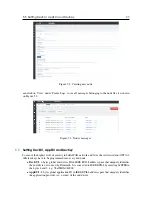
28
Chapter 5. Quick Installation Guide
•
DevKey
- 16 bytes unique AES-128 key
These keys are programmed by MatchX and stored in a special region of the nonvolatile memory
of the Dialog microcontroller. They will be preserved during flashing of the new firmware, however
they will be lost by performing full flash erase. The default values are defined in
lora\param.c
.
In Dev Kit Firmware the values of these keys are printed on UART console on power up, see Figure
5.4. On default DKF configures pins 5 and 6 on the J102 connector to be UART TX and RX
respectively, a UART-to-USB converter needs to be connected to these pins to see the messages.
Figure 5.4: Displaying the keys on UART console.
The values of DevEUI, AppEUI and DevKey can also be changed from UART console by using
param
command. The syntax is as follow:
param
x value
where x = 0 for DevEUI, 1 for AppEUI and 2 for DevKey, value is a hexadecimal value to be
set.
When value field is not specified the command will output current value of the parameter
(except DevKey, which will not be shown).
DevKey is a AES-128 encryption key used for secure communication. It should be kept secret
and only known to the sensor owner, this is why it is recommended to not display it on the UART
in a final version of the firmware by removing
#define DEBUG
line in
param.c
file. It is also
recommended to change its value before registering the node on the server.
5.6
Region Selection
Dev Kit Firmware implements different regional settings according to regulations applicable to
these regions. By default the board determines which settings to choose by reading the jumpers
configuration on connector J103 during startup. Jumpers placement is shown on Figure 5.5 and
configuration settings in Table 5.1.
The jumper configuration is read only if the settings are not programmed to internal memory
of the module. It is possible to program these settings using UART similarly to programming the
DevEUI in paragraph 5.5. In this case the jumper values are ignored and J103 pins can be used as
regular GPIOs. The syntax is as follow:














































